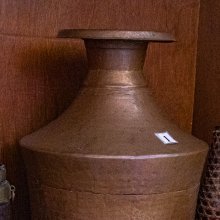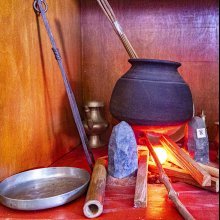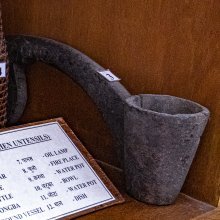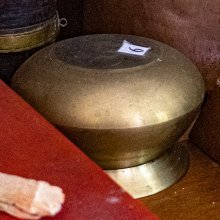Kuda, Kudā: 9 definitions
Introduction:
Kuda means something in Hinduism, Sanskrit, Buddhism, Pali, Marathi, Jainism, Prakrit, Hindi, biology. If you want to know the exact meaning, history, etymology or English translation of this term then check out the descriptions on this page. Add your comment or reference to a book if you want to contribute to this summary article.
Images (photo gallery)
(+7 more images available)
In Hinduism
Ayurveda (science of life)
Source: Advances in Zoology and Botany: Ethnomedicinal List of Plants Treating Fever in Ahmednagar District of Maharashtra, IndiaKuḍā in the Marathi language refers to the medicinal tree “Holarrhena antidysenterica (Roth.) A. DC Syn.Holarrhena pubescens (Buch.-Ham.) Wall. ex G.Don.”, and is used for ethnomedicine treatment of Fever in Ahmednagar district, India. The parts used are: “Dried seeds”. Instructions for using the tree named Kuḍā: 2 g dried seed powder—in a glass of milk twice a day.

Āyurveda (आयुर्वेद, ayurveda) is a branch of Indian science dealing with medicine, herbalism, taxology, anatomy, surgery, alchemy and related topics. Traditional practice of Āyurveda in ancient India dates back to at least the first millenium BC. Literature is commonly written in Sanskrit using various poetic metres.
Biology (plants and animals)
Source: Wisdom Library: Local Names of Plants and DrugsKuda [कुडा] in the Marathi language is the name of a plant identified with Hymenodictyon orixense (Roxb.) Mabb. from the Rubiaceae (Coffee) family having the following synonyms: Hymenodictyon excelsum, Cinchona excelsa. For the possible medicinal usage of kuda, you can check this page for potential sources and references, although be aware that any some or none of the side-effects may not be mentioned here, wether they be harmful or beneficial to health.
Source: Google Books: CRC World Dictionary (Regional names)1) Kuda in India is the name of a plant defined with Holarrhena pubescens in various botanical sources. This page contains potential references in Ayurveda, modern medicine, and other folk traditions or local practices It has the synonym Laseguea glabra A. DC. (among others).
2) Kuda is also identified with Wrightia antidysenterica It has the synonym Nerium zeylanicum L. (etc.).
3) Kuda is also identified with Wrightia tinctoria.
Example references for further research on medicinal uses or toxicity (see latin names for full list):
· Biotechnol. J.
· Annales des Sciences Naturelles; Botanique (1844)
· Fl. Siam. (1939)
· Phytochemistry (1990)
· Records of the Botanical Survey of India (1953)
· Flora Brasiliensis (1860)
If you are looking for specific details regarding Kuda, for example side effects, diet and recipes, extract dosage, health benefits, pregnancy safety, chemical composition, have a look at these references.

This sections includes definitions from the five kingdoms of living things: Animals, Plants, Fungi, Protists and Monera. It will include both the official binomial nomenclature (scientific names usually in Latin) as well as regional spellings and variants.
Languages of India and abroad
Pali-English dictionary
Source: Sutta: The Pali Text Society's Pali-English DictionaryKudā, see under ku°. (Page 221)

Pali is the language of the Tipiṭaka, which is the sacred canon of Theravāda Buddhism and contains much of the Buddha’s speech. Closeley related to Sanskrit, both languages are used interchangeably between religions.
Marathi-English dictionary
Source: DDSA: The Molesworth Marathi and English Dictionarykuḍa (कुड).—ind Interjection used in driving off fowls &c.
--- OR ---
kuḍā (कुडा).—m (kuṭaja S) A medicinal shrub, Echites anti dysenterica. Rox. Coraya Conessi, or Ovalleaved rosebay. The seed (kuḍyācēṃ bīja) is classed amongst the upadhānyēṃ and is a vermifuge &c. 2 A sort of rice. 3 A certain ear-ring of females. 4 A tree, Hymenodyction excelsum. Grah.
--- OR ---
kuḍā (कुडा).—a (Usually manācā kuḍā) False, guileful, malignant, perfidious, treacherous. 2 Bad or false--money. Ex. āpulā asatāṃ dāma kuḍā || maga pārakhyāśīṃ jhagaḍā kāsayā ||. Used only in poetry. 3 (Poetry.) False or bad gen., i. e. evil, harmful, wrong &c. Ex. pāhilēṃ paratōnī duṣṭā kāḷākaḍē || maga mhaṇē kuḍēṃ jhālēṃ ātāṃ || tukā mhaṇē kuḍī prāṇācī āvaḍī ||.
--- OR ---
kūḍa (कूड).—m (kuḍya S A wall.) A wall of slight sticks, laths, slittings of bamboo &c. plastered over with mud; a wall of wattle and dab. v ghāla. Pr. rikāmā nhāvī kuḍālā tumbaḍī lāvī. 3 f The body. Used mostly in contrad. from the soul or animating principle, or in anger and revilingly, and thus in a manner corresponding to the use in English of Carcass. 2 A fence (as of young trees widely planted); a loose or thin fence.
--- OR ---
kūḍa (कूड).—a C False, perfidious, evil-minded: also dark and guileful.
Source: DDSA: The Aryabhusan school dictionary, Marathi-Englishkuḍā (कुडा).—m A medicinal shrub. a False, guileful, malignant, treacherous.
--- OR ---
kūḍa (कूड).—f The body. m A wall of slight sticks, &c. A fence.
Marathi is an Indo-European language having over 70 million native speakers people in (predominantly) Maharashtra India. Marathi, like many other Indo-Aryan languages, evolved from early forms of Prakrit, which itself is a subset of Sanskrit, one of the most ancient languages of the world.
Hindi dictionary
Source: DDSA: A practical Hindi-English dictionary1) Kuda in Hindi refers in English to:—(nm) a large earthen bowl/pot; —[karana] to devastate, to undo, to ruin..—kuda (कुंडा) is alternatively transliterated as Kuṃḍā.
2) Kūḍā (कूडा):—(nm) rubbish; sweepings, refuge; trash; —[karakaṭa] scourings, waste materials, rubbish, midden; ~[khānā] rubbish dump; [kūḍedāna] a dust-bin; —[karanā] to spoil, to mar; [kūḍe ke bhī dina phirate haiṃ] every dog has his day.
3) Kūda (कूद) [Also spelled kud]:—(nf) a leap, jump; —[phāṃda] gambols.
...
Prakrit-English dictionary
Source: DDSA: Paia-sadda-mahannavo; a comprehensive Prakrit Hindi dictionary1) Kuḍa (कुड) in the Prakrit language is related to the Sanskrit word: Kuṭa.
2) Kūḍa (कूड) also relates to the Sanskrit word: Kūṭa.
3) Kūḍa (कूड) also relates to the Sanskrit word: Kūṭa.
4) Kūḍa (कूड) also relates to the Sanskrit word: Kūṭa.
5) Kūḍa (कूड) also relates to the Sanskrit word: Kūṭa.
Prakrit is an ancient language closely associated with both Pali and Sanskrit. Jain literature is often composed in this language or sub-dialects, such as the Agamas and their commentaries which are written in Ardhamagadhi and Maharashtri Prakrit. The earliest extant texts can be dated to as early as the 4th century BCE although core portions might be older.
Kannada-English dictionary
Source: Alar: Kannada-English corpusKuḍa (ಕುಡ):—
1) [noun] the part of a plough that cuts the soil; a plough-share.
2) [noun] an iron bar used to burn a mark on the skin; a branding-rod.
--- OR ---
Kuḍa (ಕುಡ):—[noun] the plant Wrightia tinctoria (= W. rothii) of Apocynaceae family; sweet indigo.
--- OR ---
Kūḍa (ಕೂಡ):—
1) [adverb] in the company of; in conjunction with; in association with.
2) [adverb] accompanied by; along with.
3) [adverb] even (used as an intensive or emphatic particle meaning - 'though it may seem improbable').
Kannada is a Dravidian language (as opposed to the Indo-European language family) mainly spoken in the southwestern region of India.
See also (Relevant definitions)
Starts with (+295): Kuda-chal, Kudaa, Kudaar, Kudaba, Kudabhava, Kudabhi, Kudabuda, Kudabudanem, Kudabudem, Kudaca, Kudacalepani, Kudacana, Kudacanam, Kudadi, Kudadi-ishi, Kudaga, Kudagale, Kudagappala, Kudaghai, Kudagu.
Ends with (+65): Adakuda, Akkuda, Bhadavilakuda, Bhakkuda, Bhekuda, Bokkuda, Bokuda, Chankuda, Cittakuda, Daun kaki kuda, Dhukudapukuda, Ekor kuda, Gokuda, Gonkuda, Gulab-kuda, Hadasinkuda, Hedasinkuda, Kaalakuda, Kakadakuda, Kakuda.
Full-text (+87): Kuta, Indrajava, Kudepaka, Kud, Kudamedhica, Maragini, Tambada Kuda, Kudaghai, Kutavam, Meetha kuda, Kudabhava, Wakuru-kuda, Ekor kuda, Pandhara-kuda, Kuru kuda tana, Rumput kuda, Karakata, Tapak kuda kechik, Kayu kuda, Kala kuda.
Relevant text
Search found 13 books and stories containing Kuda, Kudā, Kuḍa, Kuḍā, Kūḍa, Kūḍā, Kūda; (plurals include: Kudas, Kudās, Kuḍas, Kuḍās, Kūḍas, Kūḍās, Kūdas). You can also click to the full overview containing English textual excerpts. Below are direct links for the most relevant articles:
Amaravati Art in the Context of Andhra Archaeology (by Sreyashi Ray chowdhuri)
Resemblance to Deccan art < [Chapter 5 - Impact of Amarāvatī Art]
Amarāvatī impact on later schools of Indian art < [Chapter 5 - Impact of Amarāvatī Art]
Middle Chola Temples (by S. R. Balasubrahmanyam)
Temples in Attur < [Chapter II - Temples of Rajaraja I’s Time]
Pallava period (Social and Cultural History) (by S. Krishnamurthy)
Dressing style of warriors and dancers < [Chapter 4 - Material Culture of the People]
Musicians, dancers and theater artists < [Chapter 3 - Socio-Religious Life]
Vaishnavism during the Pallava period < [Chapter 3 - Socio-Religious Life]
Atharvaveda and Charaka Samhita (by Laxmi Maji)
4b. Leprosy (Kuṣṭha) in the Caraka-saṃhitā < [Chapter 5 - Diseases and Remedies in Atharvaveda and Caraka-Saṃhitā]
2b. Tuberculosis (Yakṣmā or Rājayakṣmā) in the Caraka-Saṃhita < [Chapter 5 - Diseases and Remedies in Atharvaveda and Caraka-Saṃhitā]
Diaspora of Bhuta (Daiva) worshipping cult—India and Indonesia (by Shilpa V. Sonawane)
Part 9 - Different Types of Spirits Worshipped in Austroasean Belt < [Chapter 4 - Inter-Disciplinary Analysis]
The Feminine Psyche in the Poem of Kamala Das and < [July – September, 2003]
Reviews < [January 1971]
Related products







